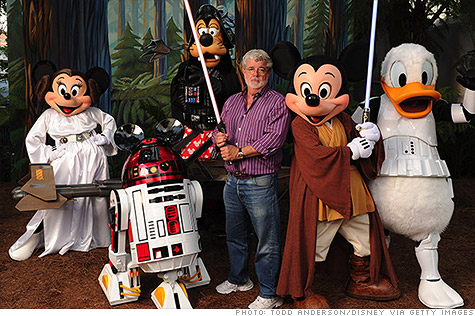“For the past 35 years, one of my greatest pleasures has been to see Star Wars passed from one generation to the next,” Lucas, the sole shareholder of Lucasfilm, said in a press release announcing the acquisition. “It’s now time for me to pass Star Wars on to a new generation of filmmakers.”
“Lucasfilm reflects the extraordinary passion, vision and storytelling of its founder, George Lucas,” Disney chairman and CEO Bob Iger said in a statement. “This transaction combines a world-class portfolio of content including Star Wars, one of the greatest family entertainment franchises of all time, with Disney’s unique and unparalleled creativity across multiple platforms, businesses and markets to generate sustained growth and drive significant long-term value.”And speaking of the Star Wars franchise, Disney announced that Episode 7 of Star Wars is forthcoming (scheduled for release in 2015), with other Star Wars franchise films to follow every 2-3 years.
The announcement was only the most recent of a number of business moves that should help cement Disney's pre-eminance in a range of creative content-based industries - the acquisition of Capital Cities/ABC through merger in 1996 (which included ESPN), comic book publisher Marvel in 2009, producers of a number of children's TV programs (Muppets, DIC, Sabane (Power Rangers)), and Pixar in 2006. The move seems to cement Disney's preeminence in the superhero and Sci-Fi/Fantasy market.
While the decision of George Lucas to sell Lucasfilm and withdraw from the business came as a surprise, the sale to Disney shouldn't have been. Both Lucas and Disney are considered to be among the smartest media business operators who have consistently taken a long-term approach to growing their business rather than focusing on short-term profit maximization. Both also shared an awareness that good creative content was exploitable beyond the initial media product release.
Disney in particular has had a long tradition of exploitation of creative intellectual properties, epitomized by Disneyland (a theme park incorporating Disney characters), the first movie studio to use television to further promote and exploit its movies and theme park (starting with the Disneyland series in 1954), long term recognition and exploitation of licensing and merchandizing its creations, and its pioneering distribution strategy for its animated movies. Disney recognized quite early that the primary audience for many of its animated features were children, and that that market had some distinctive characteristics - mainly that children grow up, while others are born to replace them. Disney recognized that he could exploit that feature by re-releasing animated features every 7-10 years to a new audience; and until the rise of recordable media that was Disney's film distribution strategy.
George Lucas was also known for his innovative business practices as well as his creative acumen. Lucas' first big success came from the film American Graffiti, both as a hit film and as an innovative financial arrangement. Rather than take a big salary and/or a percentage of profits - the industry norm - Lucas got a deal that provided him less upfront money, but a smaller percentage of the film's gross revenues. In essence, Lucas bet on his own success, and American Graffiti, produced at a cost of $775,000, went on to earn more than $200 million in box office and home video sales alone. Lucas' earnings allowed him to create Lucasfilm in 1971, special effects powerhouse Industrial Light & Magic, and largely self-finance Star Wars; and once again Lucas struck an innovative distribution deal with Fox - once again Lucas took a smaller salary in return for keeping licensing and merchandizing rights for the Star Wars creative franchise. Star Wars became the highest grossing film in the industry's history (until surpassed by E.T. five years later), with global earnings of more than $775 million to date. Those earnings allowed Lucas to self-finance the rest of the Star Wars and Indiana Jones films, while insisting on retaining licensing and merchandising rights. Lucas quipped that Disney's long history of protecting, nurturing, and - yes - exploiting, of its creative content and intellectual property meant that he could trust them to take good care of his signature creative franchises.
"I really wanted to put the company somewhere in a larger entity which could protect it," (Lucas) said.
In an interview he gave to fan magazine Empire earlier this year, Lucas had indicated he wanted to move away from the corporate side.
"I'm moving away from the company, I'm moving away from all my businesses, I'm finishing all my obligations and I'm going to retire to my garage with my saw and hammer and build hobby movies.There's a couple of lessons here for creative content producers and media outlets in the digital age. Both Disney and Lucas recognized that the value of creative content is not limited to its initial production and release, but can be translated into value in other markets; both were adept at innovative exploitation of that value; and both recognized the importance of keeping and protecting intellectual property rights. All key lessons for content producers in a digital media environment.
"I've always wanted to make movies that were more experimental in nature, and not have to worry about them showing in movie theaters."
Sources - Disney to buy "Star Wars" producer for $4.05 billion, Reuters
Disney to Buy Lucasfilm for $4.05 Billion; New 'Star Wars' Movie Set for 2015, The Hollywood Reporter
Disney Buys Lucasfilm for $4B, Targets Star Wars: Episode 7 for 2015. Wired.com

No comments:
Post a Comment